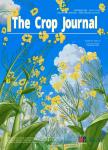Identification of a novel seed size associated locus SW9-1 in soybean
Identification of a novel seed size associated locus SW9-1 in soybean作者机构:School of Agronomy Anhui Agricultural University Hefei 230036 Anhui China The National Key Facility for Crop Gene Resources and Genetic Improvement (NFCRI)/Key Laboratory of Crop Gene Resource and Germplasm Enhancement (MOA) Institute of Crop Sciences Chinese Academy of Agricultural Sciences Beijing 100081 China Biology Department Saint Mary's University Halifax NS B3H 3C3 Canada College of Horticulture Anhui Agricultural University Hefei 230036 Anhui China
出 版 物:《The Crop Journal》 (作物学报(英文版))
年 卷 期:2019年第7卷第4期
页 面:548-559页
核心收录:
学科分类:09[农学]
基 金:supported by the National Key Research and Development Program of China (2016YFD0100201) the National Natural Science Foundation of China (31771819) the China Postdoctoral Science Foundation (2017M621990) the Introduced Leading Talent Research Team for Universities in Anhui Province the Natural Science Foundation of Anhui Province, China (1608085QC66)
主 题:Soybean [Glycine max (L.) Merr.] Seed size/weight SW9-1 Molecular breeding
摘 要:Seed size is one of the vital traits determining seed appearance, quality, and yield. Untangling the genetic mechanisms regulating soybean 100-seed weight (100-SW), seed length and seed width across environments may provide a theoretical basis for improving seed yield. However, there are few reports related to QTL mapping of 100-SW across multiple ecological regions. In this study, 21 loci associated with seed size traits were identified using a genome-wide association of 5361 single nucleotide polymorphisms (SNPs) across three ecoregions in China, which could explain 8.12%–14.25% of the phenotypic variance respectively. A new locus, named as SW9-1 on chromosome 9 that explained 10.05%–10.93% of the seed weight variance was found significantly related to seed size traits, and was not previously reported. The selection effect analysis showed that SW9-1 locus has a relatively high phenotypic effect (13.67) on 100-SW, with a greater contribution by the accessions with bigger seeds (3.69) than the accessions with small seeds (1.66). Increases in seed weight were accompanied by increases in the frequency of SW9-1T allele, with 90% of the bred varieties with a 100-SW 30 g carrying SW9-1T. Analysis of SW9-1 allelic variation in additional soybean accessions showed that SW9-1T allele accounting for 13.83% of the wild accessions, while in 46.55% and 51.57% of the landraces and bred accessions, respectively, this results indicating that the SW9-1 locus has been subjected to artificial selection during the early stages of soybean breeding, especially the utilization of SW9-1T in edamame for big seed. These results suggest that SW9-1 is a novel and reliable locus associated with seed size traits, and might have an important implication for increasing soybean seed weight in molecular design breeding. Cloning this locus in future may provide new insights into the genetic mechanisms underlying soybean seed size traits.



